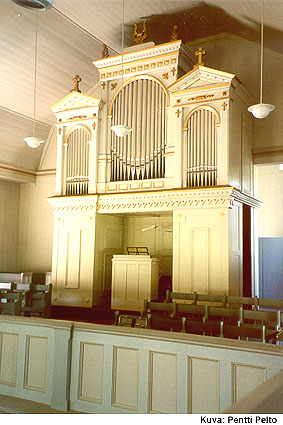
|
HISTORICAL ORGANS IN FINLAND 
Yläne Church- Thulé, Bror Axel 1888
- 14 stops, 2 manuals and pedal
- mechanical action and mechanical stop action
The Church of St Olaf in Yläne was built by Mikael Piimänen in 1782. It is a hybrid of a cruciform church and a nave church; it is long but fitted with transepts, with adjoining porch and sacristy. There is a steeple with an onion dome at the west end.
Bror Axel Thulé built an organ in the loft in 1888. There was enough space above the loft to place the chests high and to build the console under them; although height was no problem, there was little depth. Oy Kangasalan Urkutehdas Ab built a new bellows, altered the disposition and added a blower in 1967. The action and chests were not changed. The Yläne organ is an example of a period when mechanical organs were fitted with accessories typical for pneumatic actions. The instrument has a beautiful, singing sound.
Appearance
The façade consists of three flats. The middle, oblong one is the largest. It is flanked by pediment-topped side flats that protrude slightly more than the middle flat. All façade pipes are mute. The case is white, with gilt ornaments.
The chests are placed side by side behind the façade. The Pedal chest, divided into two halves, is in the middle, flanked by the Manual II chests, which are in turn flanked by the Manual I chests. This enables tuning of the trumpet stop through the end walls of the organ. The chests are turned so that the stops run parallel to the axis of the church, with the treble ends nearest to the façade. The bellows are behind the chests; these are the only surviving box bellows built by Bror Axel Thulé.
Technical features
The chests are of a design patented by Bror Axel Thulé, with a wholly mechanical action from the console. The console is in a niche under the façade. The keys have ebony and ivory coverings. Above the keyboards are the square stop keys, which are pressed to activate the stops. The stops are deactivated by pressing the stop labels above the knobs. The organ has one additive combination and a mechanical general crescendo pedal.
The action runs under the console, then turns towards the sides and up to the chests. The box bellows are linked by the wind trunk, which runs at the bass end of the chests. The action passes along the centre line of the organ as a narrow bundle of sliders to the wind trunk and then fans out to the stop pallets. The action routing problem appears to have been solved with ease by the designer.
In the 1967 repairs, the box bellows were left in place but disconnected. A new double rise reservoir was fitted on top of them, passing the wind through the channel of one of the box bellows to the wind trunk.
Musical properties
Because of the stop channel chest, the touch seems slow. This is because each pallet opens at a different time, and there is no ‘pluck’ typical of a mechanical action. However, the touch remains light even with couplings activated.
The Principal pipes have a tin content of about 60%, while the flute pipes have about 30%. The large wood pipes are of pine, the small ones of varnished birch. The sound is serene and singing; the wind pressure is moderate, since the church is small and acoustically sensitive. The disposition contains two overblowing stops, even though the instrument is relatively small.
Original disposition
Manual I, C-f3 | Manual II, C-f3 | Pedal C-d1 |
Borduna 16’ | Geig.principal 8’ | Subbass 16f |
Principal 8’ | Rörflöjt 8’ | Violoncello 8f |
Gedacht 8’ | Viola di Gamba 8’ | |
Flöjt harmoniqve 8’ | Flöjt octaviante 4’ | |
Octava 4’ | | |
Qvinta 3’ | | |
Octava 2’ | | |
Trompete 8’ | | |
| | |
| | II-I, I-Ped, II-Ped, I 4’, II-I 16’ |
| | Additive free combination |
| | General crescendo pedal |
| | |
Present disposition
Manual I, C-f3 | Manual II, C-f3 | Pedal C-d1 |
Principal 8’ | Rörflöjt 8’ | Subbass 16’ |
Gedacht 8’ | Principal 4’ | Violoncello 8’ |
Flöjt harmoniqve 8’ | Flöjt octaviante 4’ | |
Octava 4’ | Waldflöte 2’ | |
Gemshorn 4’ | | |
Qvinta 3’ | | |
Octava 2’ | | |
Mixtur 3x 1 1/3’ | | |
| | |
| | |
| | |
| | |
| | |
Further information
Pentti Pelto, Kaksi suomalaista urkuperinnettä. Sibelius Academy, Vammala 1994.
There are plans to restore the organ to its original state.
|